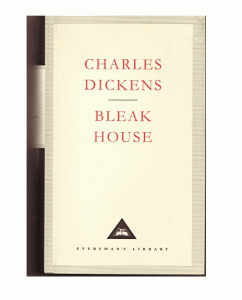 Bleak House is, according to some, one of Dickens’ best books. I thought I better read it.
Bleak House is, according to some, one of Dickens’ best books. I thought I better read it.
At the heart of the story is a long-running civil law suit, and the effect this has on the young wards of the court. It is also a story about secrets and mysteries, including a hidden scandal and, in the closing sections of the book, a murder.
Famously the book begins with an extended description of a London fog. And this just about sums up the book. It is full of description – of London, of country scenes, of characters, of the interior and exterior of houses. The language is beautiful. But the story unfolds at the tortuous pace of a lame tortoise.
My edition was 880 pages long and, believe me, it felt even longer.
What I didn’t like about Bleak House
The story is told from two points of view.
- One voice belongs to an omniscient narrator, who speaks in the present tense and third person. This is where some of the most beautiful descriptions lie, but it is also Dickens at his most annoying: pretentious, long-winded, ramming home messages, using unsubtle humour, and being generally irritating.
- The other voice belongs to Esther, a pivotal character in the book. Esther’s narrative is related is the first person, past tense, and, in my opinion, this is where the book really comes to life. Esther is, however, also rather annoying, being a terribly passive and overly modest creature – almost too good to be true. Actually… definitely too good to be true.
The underlying plot is not particularly complex, but it appears convoluted because the novel is so very long-winded. It was originally published in 19 monthly installment and I don’t know how any of its readers managed to remember who was who or keep track of events.
Perhaps the work has more in common with a modern soap opera than a modern novel. Characters appear for no good reason, and then disappear. There are little sub-plots which seem to be dropped into the narrative for no specific reason and could have been removed without substantially altering the central thread of story.
What I liked about Bleak House
I did like the brave mix of narrative voices, and was surprised to discover the omniscient narrator telling his story in the present tense. The present tense is very fashionable at the moment, particularly in young adult fiction, and controversial too, with some critics decrying it. And yet here was Dickens using the present tense over 150 years ago. [Controversial? Yes. Just read the comments following Richard Lea’s article about the rise of the present tense, published in the Guardian, Saturday 21st November, 2015.]
The most interesting character was introduced in the final chapters of the book. Mr Inspector Bucket. ‘A sagacious, indefatigable detective officer.’ Unfailingly polite, apparently both empathetic and sympathetic, he is driven by a desire to uncover the truth. Dickens may have intended Bleak House to be a political satire about the failings of the judicial system, but he appears to have invented a new genre: the detective story.
There is a great deal more I could say about Bleak House, but I think I’ll leave it there. Despite all my criticisms, I’m glad I read it.
When I was a teacher – oh, I am a teacher again! – when I was an English teacher – I used to use the first page or so of Bleak House as an example of writing that has no main verb.
I think the first chapter is beautifully written. Maybe the best way to read this book is in 20 installments? I found myself skipping over the descriptions and dying for some action.
Maybe the beginning of his novels are the best:
IT was the best of times, it was the worst of times, it was the age of wisdom, it was the age of foolishness, it was the epoch of belief, it was the epoch of incredulity, it was the season of Light, it was the season of Darkness, it was the spring of hope, it was the winter of despair, we had everything before us, we had nothing before us, we were all going direct to Heaven, we were all going direct the other way- in short, the period was so far like the present period, that some of its noisiest authorities insisted on its being received, for good or for evil, in the superlative degree of comparison only.
I think pre-Tv, pre-internet readers had a lot more patience. It seems that most of the old classics use words like they’re being paid for each one. But the stories are priceless.
Indeed. Perhaps could have done with some ‘culling’ 😉